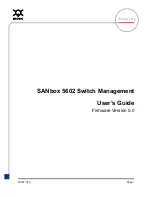
145
snmp-server engineID
Description
The
snmp-server engineID
command is used to configure the local and remote
engineID of the switch. To restore to the default setting, please use
no
snmp-server engineID
command.
Syntax
snmp-server engineID
{ [
local
local-engineID
] [
remote
remote-engineID
] }
no snmp-server engineID
Parameter
local-engineID
——
Local Engine ID for local clients. The Engine ID is a unique
alphanumeric string used to identify the SNMP engine on the switch. Its length
ranges from 10 to 64 hexadecimal characters, which must be even number
meanwhile.
remote-engineID
——
Remote Engine ID for the switch. The Engine ID is a
unique alphanumeric string used to identify the SNMP engine on the remote
device which receives informs from the switch. Its length ranges from 10 to 64
hexadecimal characters, which must be even number meanwhile. The
snmp-server engineID
will be disabled if the
local
and
remote
are both not
configured.
Command Mode
Global Configuration Mode
Example
Specify the local engineID as 1234567890, and the remote engineID as
abcdef123456:
TL-SL2428(config)# snmp-server engineID local
1234567890
remote
abcdef123456
snmp-server traps snmp
Description
The
snmp-server
traps snmp
command is used to enable SNMP standard
traps which include four types: linkup, linkdown, warmstart and coldstart. To
disable the sending of SNMP standard traps, please use
no snmp-server traps
snmp
command.












































